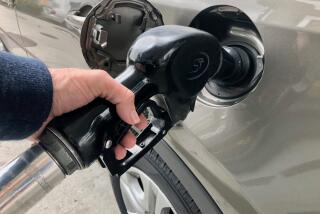Residents Revel in Low Gas Prices
- Share via
Despite a more than 10-cent discrepancy between some communities in the price for a gallon of gasoline, Ventura County residents are reveling in the money they’re now saving at the pump.
“I keep a pretty tight wallet, but now with these prices, I don’t have to worry so much about those extra trips,” said 29-year-old Michael Fine of Thousand Oaks, who commutes to Hollywood every day. “It’s a relief, especially for someone like me.”
Statewide, the average price is $1.10 per gallon, with many areas in Ventura County averaging more than 10 cents less--prices that haven’t been seen since 1991.
And those rock-bottom prices could dip even further, some experts believe, if the unprecedented confluence of global events that has been driving prices down continues.
“It’s like the Earth, sun, moon and stars have all lined up,” said Jan Speelman, executive director of the Automobile Trade Organization of Southern California, which represents about 1,200 area gasoline retailers. “The days of these kinds of prices are few and far between. . . . It’s a welcome relief for customers who were paying upwards of $1.50 for gas a year ago.”
And nowhere is that more evident than in Simi Valley, where prices are the lowest of any city in Ventura County, saving customers several dollars every time they fill up.
“It’s amazing,” Judy Blankenship said as she filled the tank of her Chrysler Le Baron for a mere $11.25 at a station at Madera and Tierra Rejada roads. “It’s like we’re back in the ‘50s or something.”
Close, but not quite.
According to Claudia Chandler, an official at the California Energy Commission, the prices for gasoline are at a 28-year low when adjusted for inflation.
In 1970, she said, the average price per gallon was 34 cents, which translates to about $1.27 in 1997 dollars.
“It’s a somewhat unprecedented thing we’re seeing right now,” Chandler said. “Every year, prices drop from January through May, but what’s surprising is how much they’ve fallen. . . . It’s something that no one could have predicted.”
Caused by what some have called a lucky political, economic and meteorological alignment of events around the globe, the price of gasoline has been steadily dropping since September, when the average per gallon hovered around $1.44.
Chandler said the lower prices are due to several factors, including El Nino, the Asian economic crisis and the United Nations’ decision to increase the amount of Iraqi oil exports.
While El Nino has left California with one of its wettest years in history, it has also resulted in one of the warmest winters on record, which has diminished the nation’s demand for home heating oil.
Additionally, Asia’s once red-hot economies, some of which were growing at exponential rates, have cooled, lessening the demand for crude oil on the world market.
And Iraq, which had once been allowed to export only meager amounts of crude from its expansive reserves, has been allowed to export more in the U.N.’s food-for-oil program.
Those events, Chandler said, have resulted in an enormous glut of oil on the world market, which has cut the price for a barrel of crude to below $20.
On Monday, the price for a barrel of Alaskan crude sold for $18, which Chandler said was a “phenomenally low price.”
Whatever the reason, Omer Drury and his wife, Elaine, of Troy, Idaho, said the prices were too good to pass up.
While on his way to Loma Linda to attend his medical school’s 50-year reunion, the 82-year-old said he spotted a 94-cent sign and turned around, even though his tank was far from empty.
“It’s been quite a few years since I paid that,” he said, pointing to the $24 he paid for 26 gallons. “It’s like the old days, but I wonder how long it’s going to last.”
According to industry experts, the current trend should continue through Memorial Day, when prices are expected to rise, although not as sharply as in past years.
Beginning as early as next month, prices could edge up slightly if the Organization of Petroleum Exporting Countries, which meets next week, decides to curb the amount of oil it is dumping on the market.
While some areas of the county, such as Simi Valley, have prices that fall far below $1, other communities, such as Ventura, have prices more than 10 cents higher per gallon.
And while some have speculated that those discrepancies have to do with greater distribution and transportation costs, Speelman said that’s far from the case.
“It’s called zone pricing and there’s no rhyme or reason to it,” she said. “It’s just a way for big companies to discipline the market and set the prices they want.”
According to Speelman, zone pricing occurs when one station decides to lower its price to attract more customers and bring in more profit.
When that happens, oil companies, which monitor their markets on a daily and sometimes hourly basis, also lower their prices to undercut the other station, forcing it to raise its prices.
Once those prices are raised, the oil companies follow and raise their prices to comparable levels.
“It’s sneaky and it’s discriminatory, but there’s a lot of money at stake,” she said.
Even so, that didn’t seem to bother many people, except for Cathi Noe of Simi Valley, who has made it a habit of sniffing out a bargain.
“I’ve got four kids, so every penny counts,” she said while filling the tank of her Nissan Sentra for $9.45. “I guess you just have to look around to find the best price, but it looks pretty good everywhere right now.”
More to Read
Sign up for Essential California
The most important California stories and recommendations in your inbox every morning.
You may occasionally receive promotional content from the Los Angeles Times.










